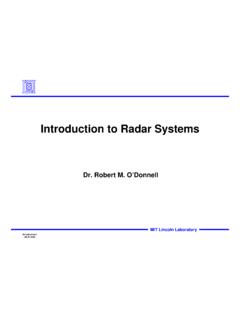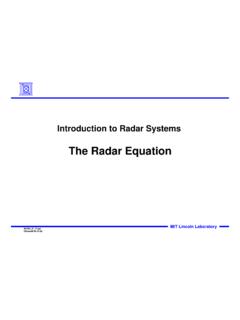Transcription of Radar Transmitter/Receiver - MIT Lincoln Laboratory
1 Radar_TxRxCoursePPhu 061902 -1 MIT Lincoln LaboratoryIntroduction to Radar Systems Radar Transmitter/ReceiverMIT Lincoln LaboratoryRadar_TxRxCoursePPhu 061802 -2 Disclaimer of Endorsement and Liability The video courseware and accompanying viewgraphs presented on this server were prepared as an account of work sponsored by an agency of the United States Government. Neither the United States Government nor any agency thereof, nor any of their employees, nor the Massachusetts Institute of Technology and its Lincoln Laboratory , nor any of their contractors, subcontractors, or their employees, makes any warranty, express or implied, or assumes any legal liability or responsibility for the accuracy, completeness, or usefulness of any information, apparatus, products, or process disclosed, or represents that its use would not infringe privately owned rights.
2 Reference herein to any specific commercial product, process, or service by trade name, trademark, manufacturer, or otherwise does not necessarily constitute or imply its endorsement, recommendation, or favoring by the United States Government, any agency thereof, or any of their contractors or subcontractors or the Massachusetts Institute of Technology and its Lincoln Laboratory . The views and opinions expressed herein do not necessarily state or reflect those of the United States Government or any agency thereof or any of their contractors or subcontractorsMIT Lincoln LaboratoryRadar_TxRxCoursePPhu 061802 -3 Outline Introduction Radar Transmitter Radar Waveform Generator and receiver Radar Transmitter/Receiver Architecture SummaryMIT Lincoln LaboratoryRadar_TxRxCoursePPhu 061802 -4 Radar Block DiagramTransmitterReceiverAntennaPropaga tionMediumTargetCrossSectionWaveformGene ratorPulseCompressionRecordingTracking &ParameterEstimation Console /DisplayDopplerProcessingA / DDetectionWe will cover this particular part of the Radar in this lecture DuplexerMIT Lincoln LaboratoryRadar_TxRxCoursePPhu 061802 -5 FilterSimplified Radar Transmitter/Receiver System Block Diagram Radar transmitter and receiver can be
3 Divided into two important subsystems High power transmitter sections Low power sections Radar waveform generator and receiver DuplexerWaveformGeneratorReceiverHigh Power AmplifierFilterLow NoiseAmplifierA/D00101111010 High Power Transmit Sections (100 s of W to 1 s MW) Low Power Transmit Section(10 s of mW to 1 W)Low Power Receive Sections( W to mW)MIT Lincoln LaboratoryRadar_TxRxCoursePPhu 061802 -6 Radar Range Equation Revisited Parameters Affected by Transmitter/Receiver Radar range equation for search (S/N = signal to noise ratio) S/N of target can be enhanced by Higher transmitted power Pav Lower system losses L Minimize system temperature Ts L T k R t AP S/Ns4seav = 4 The design of Radar Transmitter/Receiver affects these three parameters directlyPav = average power e = antenna areats = scan time for Pav = average power = Radar cross section = solid angle searchedR = target rangeTs = system temperatureL = system lossMIT Lincoln LaboratoryRadar_TxRxCoursePPhu 061802 -7 Outline Introduction Radar Transmitter Overview High Power Amplifier Radar Waveform Generator and receiver Radar Transmitter/Receiver Architecture SummaryMIT Lincoln LaboratoryRadar_TxRxCoursePPhu 061802 -8 Power Amplification Process Amplification occurs in multiple stages Driver amplifiers High power amplifier Requirement for power amplifier Low noise
4 Minimum distortion to input signalPA 2PA 2PA 1PA 1 HPA 3 HPA 3 Driver Amplifier(s) Low Power Signal(from WFG) PA = Power AmplifierHPA = High Power AmplifierMIT Lincoln LaboratoryRadar_TxRxCoursePPhu 061802 -9 Method to Obtain Higher Power Higher transmitted power can be obtained by combining multiple amplifiers in parallel Lower efficiency (due to combiner losses) Increased complexity 1 Single amplifier transmitterSingle antennaHPAD river 2 Parallel combining of HPA sSingle antennaHigh Power CombinerDriver = High Power AmplifierMIT Lincoln LaboratoryRadar_TxRxCoursePPhu 061802 -10 Types of High Power Amplifiers Vacuum tube amplifiers and solid state amplifiers Vacuum Tube Amplifiers Solid State Amplifiers Output Power High (10 kW to 1 MW)Low (10 s to 100 s W)Cost per Unit High ($10 s K to $300 K) Low ($100 s ) Cost per Watt $1 3 Varied Size Bulky and heavy Small foot print Applications Dish antenna Passive array Active array Digital array MIT Lincoln LaboratoryRadar_TxRxCoursePPhu 061802 -11 Average Power Output Versus Frequency Tube Amplifiers versus Solid State Amplifiers110610210-2104 Average Power (Watts).
5 11101001000 Frequency (GHz)Solid State Amplifiers Dominate Tube Amplifiers Dominate Region of CompetitionMIT Lincoln LaboratoryRadar_TxRxCoursePPhu 061802 -12 Power Amplifier Examples Tube amplifiers Klystrons Travelling wave tubes Solid State amplifiers Solid state power transistorsCriteria for choosing high power amplifier Average power output as a function of frequency Total bandwidth of operation Duty cycle Gain Mean time between failure (MTBF) Lincoln LaboratoryRadar_TxRxCoursePPhu 061802 -13 MIT/LL Millstone Hill Radar Klystron Tubes (Vacuum Devices) Originally designed in early 1960 s Originally designed in early 1960 sOutput deviceKlystrons (2)Center Frequency1295 MHzBandwidth8 MHzPeak Power3 MWAverage Power120 kWPulse Width1 msBeam Width Diameter84 ftMIT Lincoln LaboratoryRadar_TxRxCoursePPhu 061802 -14 How Big are High Power Klystron Tubes ?
6 Millstone Hill Radar Transmitter Room1 kW Peak Solid State Driver Amplifier RoomFlex Waveguide Output flangesWaveguide Harmonic Filter200 antenna waveguideWater Coolant Hoses, 70 Gal/minWaveguide outputVarian X780 Klystron $400,000/tube 7 ft (height) x 1ft (diameter) 600 lbs 3% duty cycle 42 dB gain 600W peak input drive levelVarian X780 Klystron $400,000/tube 7 ft (height) x 1ft (diameter) 600 lbs 3% duty cycle 42 dB gain 600W peak input drive levelVacuum PumpSpare TubeMIT Lincoln LaboratoryRadar_TxRxCoursePPhu 061802 -15 Photograph of Traveling Wave Tubes Another Type of Tube AmplifiersX BandVTX-5681C COUPLED CAVITYTWTC enter Freq : GHzBandwidth : 1 GHzPeak Power : 100 kW Duty Cycle : 35 %Gain : 50 dBS BandVTS-5753 COUPLED CAVITYTWTC enter Freq : GHzBandwidth : 400 MHz Peak Power : 160 kWDuty Cycle : 8 %Gain : 43 dB~ 8 ftS-Band Transmitter MIT Lincoln LaboratoryRadar_TxRxCoursePPhu 061802 -16 Example of Solid State Transmitter Radar Surveillance Technology Experimental Radar (RSTER) 14 channels with 140 kW total peak power 8 kW average power Each channel is supplied by a power amplifier module 10 kW peak power 14 channels with 140 kW total peak power 8 kW average power Each channel is supplied by a power amplifier module 10 kW peak powerPower Amp ModuleDriver Amp ModuleMIT Lincoln LaboratoryRadar_TxRxCoursePPhu 061802 -17 Solid State Active Phased Array Radar PAVE PAWS PAVE PAWS First all solid state active aperture electronically steered phased array Radar UHF Band 1792 active transceiver T/R modules, 340 W of peak power eachCourtesy of Raytheon.
7 Used with of Raytheon. Used with Lincoln LaboratoryRadar_TxRxCoursePPhu 061802 -18 Outline Introduction Radar Transmitter Overview High Power Amplifier Duplexer Radar Waveform Generator and receiver Radar Transmitter/Receiver Architecture SummaryMIT Lincoln LaboratoryRadar_TxRxCoursePPhu 061802 -19 Radar Transmitter/Receiver Timeline Sensitive Radar receiver must be isolated from the powerful Radar transmitter Transmitted power typically 10 kW 1 MW receiver signal power in 10 s W 1 mW Isolation provided by duplexer switching High Power PulsePulse WidthReceive WindowA/D SamplesReceiver Duplexer SwitchRadar PRI TransmitReceiveTransmitReceivePRI = Pulse Repetition IntervalMIT Lincoln LaboratoryRadar_TxRxCoursePPhu 061802 -20 Duplexer Function Transmitter ON Connect antenna to transmitter with low loss Protect receiver during transmit
8 Interval receiver ON Connect Antenna to receiver with low loss (transmitter must be turned off in this interval) Limiter/switch is used for additional protection against strong interference Limiter/SwitchLimiter/SwitchAntennaDuple xerHPAR eceiverXTransmit IntervalLimiter/SwitchLimiter/SwitchAnte nnaDuplexerHPAXR eceive IntervalReceiverHPA = High Power AmplifierMIT Lincoln LaboratoryRadar_TxRxCoursePPhu 061802 -21 Outline Introduction Radar Transmitter Overview Radar Waveform Generator and receiver Radar Transmitter/Receiver Architecture SummaryMIT Lincoln LaboratoryRadar_TxRxCoursePPhu 061802 -22 Simplified Functional Descriptions Waveform generator and receiver share several similar functions Amplification, filtering and frequency conversion Waveform Generator WaveformGenerationAmplifyUpconvertFilter ingTo AntennaCarrier SignalAmplifyDownconvertFilteringA/DFrom AntennaReceiver 10011110010 MIT Lincoln LaboratoryRadar_TxRxCoursePPhu 061802 -23 Frequency Conversion Concepts Upconverter translates the waveform frequency to a higher frequency Reason: Waveform generation less expensive at lower frequency Downconverter translates the receive frequency to a lower frequency Reason.
9 Dynamic range of A/D converter higher at lower frequency Up GHz Local Oscillator GHzL Band GHz Frequency Upconversion Baseband to L BandDownConverterL Band GHzLocal GHzTo A/D Frequency DownconversionL Band to Baseband Waveform GeneratorReceiverMIT Lincoln LaboratoryRadar_TxRxCoursePPhu 061802 -24 Simplified System Block Diagram Waveform Generator and receiver This example shows only a single stage conversion In general, design based on multiple stage of frequency conversion are employed Multiple stages of amplification and filtering are also used Low GHz(L-Band) GHzA/DWaveform Generator FilteringLocal GHz(L-Band) GHzHPAD uplexerMIT Lincoln LaboratoryRadar_TxRxCoursePPhu 061802 -25 Outline Introduction Radar Transmitter Overview Radar Waveform Generator and receiver Radar Transmitter/Receiver Architecture SummaryMIT Lincoln LaboratoryRadar_TxRxCoursePPhu 061802 -26 Dish Radars Conventional Radar Transmitter/Receiver design employed DuplexerWaveform Generator001011110100 MILLSTONEMILLSTONEHAYSTACK/HAXHAYSTACK/H AXMMWMMWALTAIRALTAIRTRADEXTRADEXALCORALC ORKWAJALEINT ransmitterReceiverA/DMIT Lincoln LaboratoryRadar_TxRxCoursePPhu 061802 -27 TRRadar Antenna Architecture Comparison Beam agility Effective Radar resource management Low loss High cost More complex cooling Beam agility Effective Radar resource management Higher cost Requires custom transmitter and high-power phase shifters High loss TRPROCON Very low cost Frequency
10 Diversity Dedicated function Slow scan rate Requires custom transmitter High lossPassive Array RadarActive Array Radar Dish RadarTRT/R ModulesMIT Lincoln LaboratoryRadar_TxRxCoursePPhu 061802 -28 Active Phased Array Radar Transmit/Receive function distributed to each module on array Waveform GeneratorA/D001011110100 HPAR eceiverDuplexerActive T/R Module Low Power SectionSubarray # T/R Subarray # T/R ..T/R T/R MIT Lincoln LaboratoryRadar_TxRxCoursePPhu 061802 -29 Large Phased ArraysPassive Array RadarCobra active elementsActive Array RadarTHAAD Radar25,344 elementsPassive Array RadarCourtesy of Raytheon. Used with of Raytheon. Used with of Raytheon. Used with Lincoln LaboratoryRadar_TxRxCoursePPhu 061802 Digital Beam(Analog Array)..MultichannelDigital Beamformer001011100011110100111100001A/D A/DA/DDigital BeamsDigital Array Radar Architecture Digital on Receive Each active analog T/R module is followed by an A/D for immediate digitization Multiple received beams are formed digitally by the digital beamformer.






